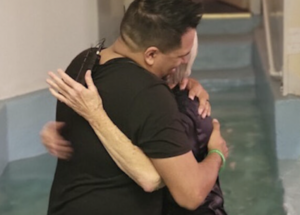
EDITOR’S NOTE: The U.S. Holocaust Memorial Museum’s annual Days of Remembrance Ceremony is today (May 5) in the U.S. Capitol.
HEATH SPRINGS, S.C. (BP) — I have had the privilege to visit a number of Holocaust museums around the world. Each time, I leave troubled and aware of an urgency and a vigilance we must all maintain against injustice.
These reminders of evil in human history cry out to contemporary culture for relentless vigilance. Disaster lurks on the horizon for those societies that become inoculated to these reminders. The question remains whether or not we will hear the cry of alarm.
I was in Poland with a group of fellow pastors last year, and we traveled the approximately 65 kilometers from Krawkow to Auschwitz, the infamous Nazi death camp where an estimated 1.1 million souls entered eternity. Auschwitz is actually a network of nearly 50 different camps and sub-camps, with Auschwitz I being the original camp and Auschwitz II-Birkenau being the largest.
Having been in the Holocaust museum in Jerusalem, I did not expect to encounter anything new at Auschwitz amid the grim scenery and the grisly photos of torture and death. Our guide ambled us through the various barracks that had been converted into display rooms for the Auschwitz museum. The electrified fence, the train rails, the guard towers, the gas chamber, the villa where camp commandant Rudolf Hoss lived with his wife and children — all appeared to be as they were when the emaciated bodies of those held there stumbled about in what seemed a meaningless hell. We saw the typical memorabilia one would expect in a Holocaust museum — display cases full of shoes, eyeglasses, brushes, shoe polish, clothes, suitcases, etc.
As we slowly snaked our way through the awful surroundings, the mood within our group became increasingly somber. Few dared speak above a whisper out of respect for the human lives who had met their end in that gruesome place. Men, women, boys, girls, young adults, the elderly — human beings with goals and ambitions — stripped of dignity and driven like cattle into the darkness and gloom of the gas chamber by the Schutzstaffel elite German police. There we stood, where millions had stood so long ago, but unlike those who came before us, we would be allowed to leave and go about our lives.
After about an hour touring the ruins of the camp, the seminal moment of the experience confronted us. The guide stopped and respectfully instructed us that pictures were not allowed in the next room we were going to enter — a room that contained human remains. My mind immediately began to ponder what kind of human remains could possibly be displayed, perhaps bones or ashes, I thought to myself.
As we entered the room the realization sank in that what I was beholding was truly a grotesque sight. Before us were mounds upon mounds of human hair. Without doubt, it is the largest collection of human hair in one location on earth — several tons of it that had been violently shaved from the heads of approximately 50,000 people. Blonde, black, brown, gray hair all collected into piles that reached the ceiling. Eerily, the hair, over decades, had continued to change colors. It had continued to gray in a ghostly reminder of lives truncated prematurely. The victims were gassed within minutes of having their heads shaved. Men with handsome locks, women with elegant curls, boys with shocks of black, little girls with beautiful braids — no distinction was made between them. They were vermin to be exterminated. I saw a long blonde braid, still perfectly braided with a red bow at the end.
I felt sharp visceral pains in my stomach and chest when I saw the mounds of hair and tears welled up in my eyes, seeing the Nazi alchemist of evil that had turned 50,000 human beings into mounds of decaying hair. The hair — their hair — is the only visible monument that they once walked this earth. They laughed and cried, they worried and experienced joy. They were human beings.
The message was clear: “I was here. I lived. Remember me.” The hair is a ghastly reminder of the deep well of evil in the human heart. There is no end to the atrocities human beings can unleash on fellow human beings.
Without God, we are capable of anything. The hair is a reminder of the fate of societies without the moral rudder of a just and righteous God.
More so — and immediate for us — the hair is a ghastly reminder of the consequences of inaction. There was inaction among many within Germany who at pivotal points in the Nazi rise to power did not stand against them. There was inaction from governments around the world leading up to the crisis of World War II, thinking the best way to deal with the Nazi threat was appeasement. There was inaction from the Allied powers when they failed to bomb the rail lines into Auschwitz because they did not believe the initial reports of what was happening at the camp.
The mounds of human hair at Auschwitz shrieks the terrible consequences of inaction. Inaction is always concomitant with fear and indifference.

















